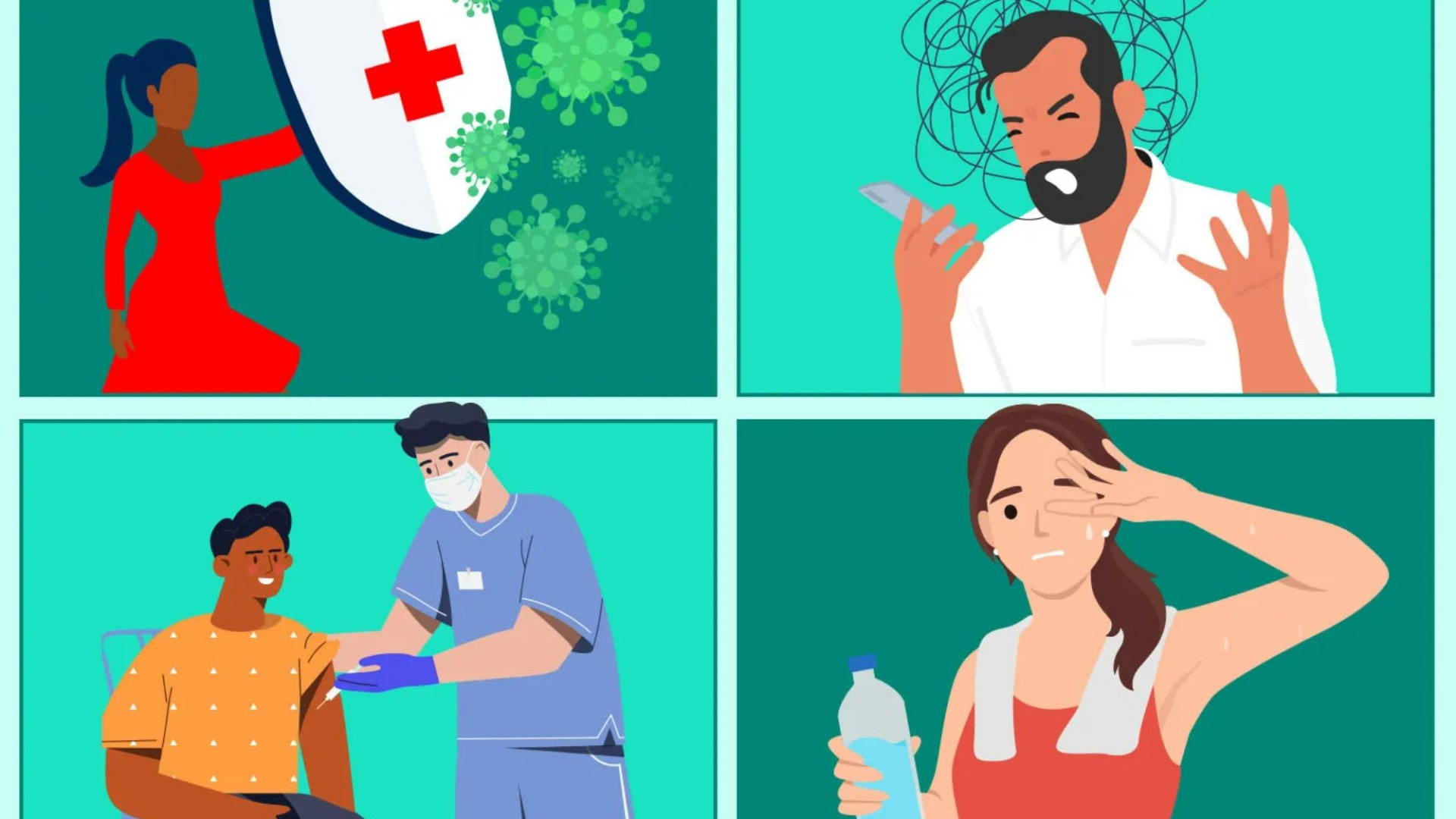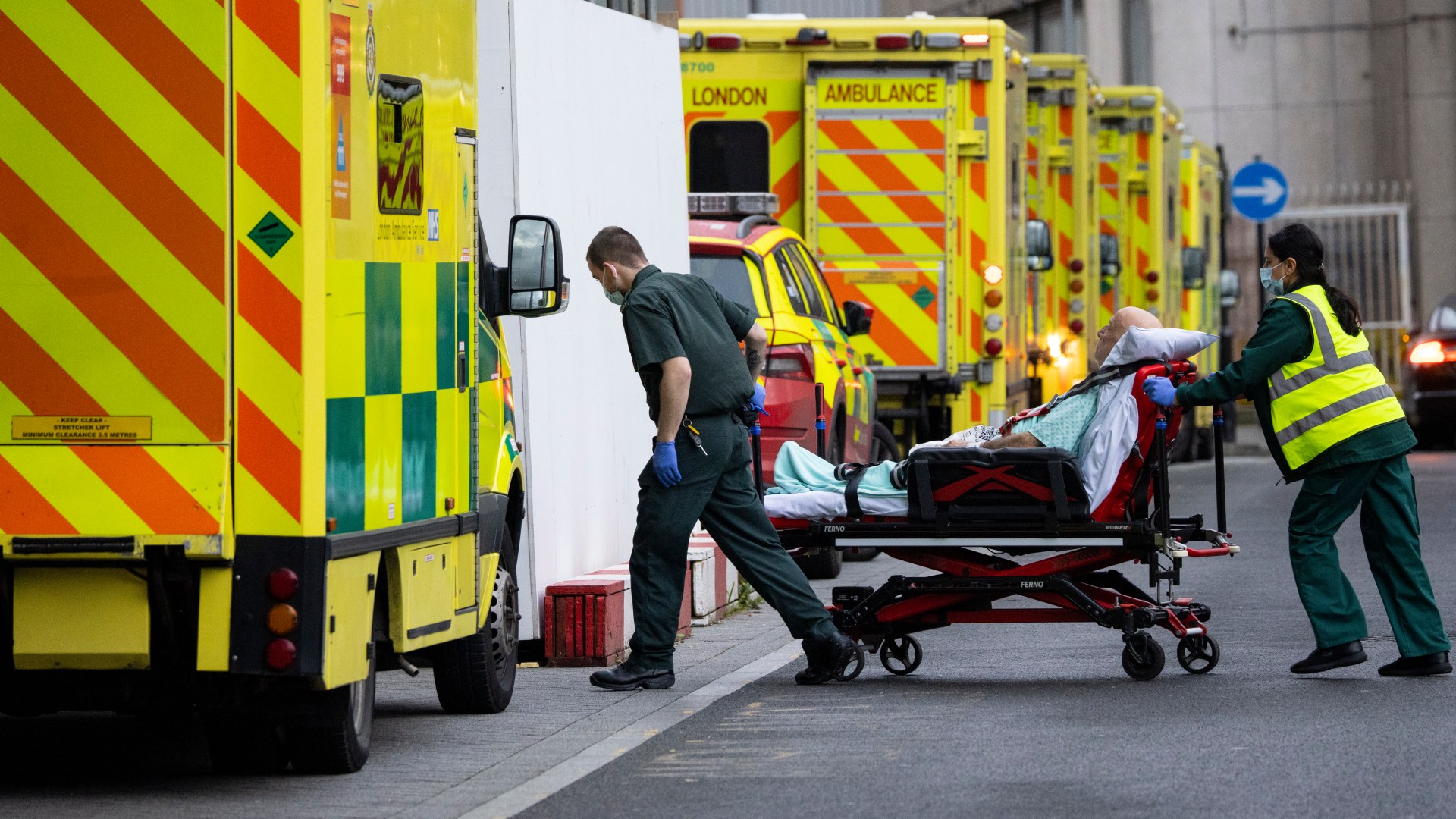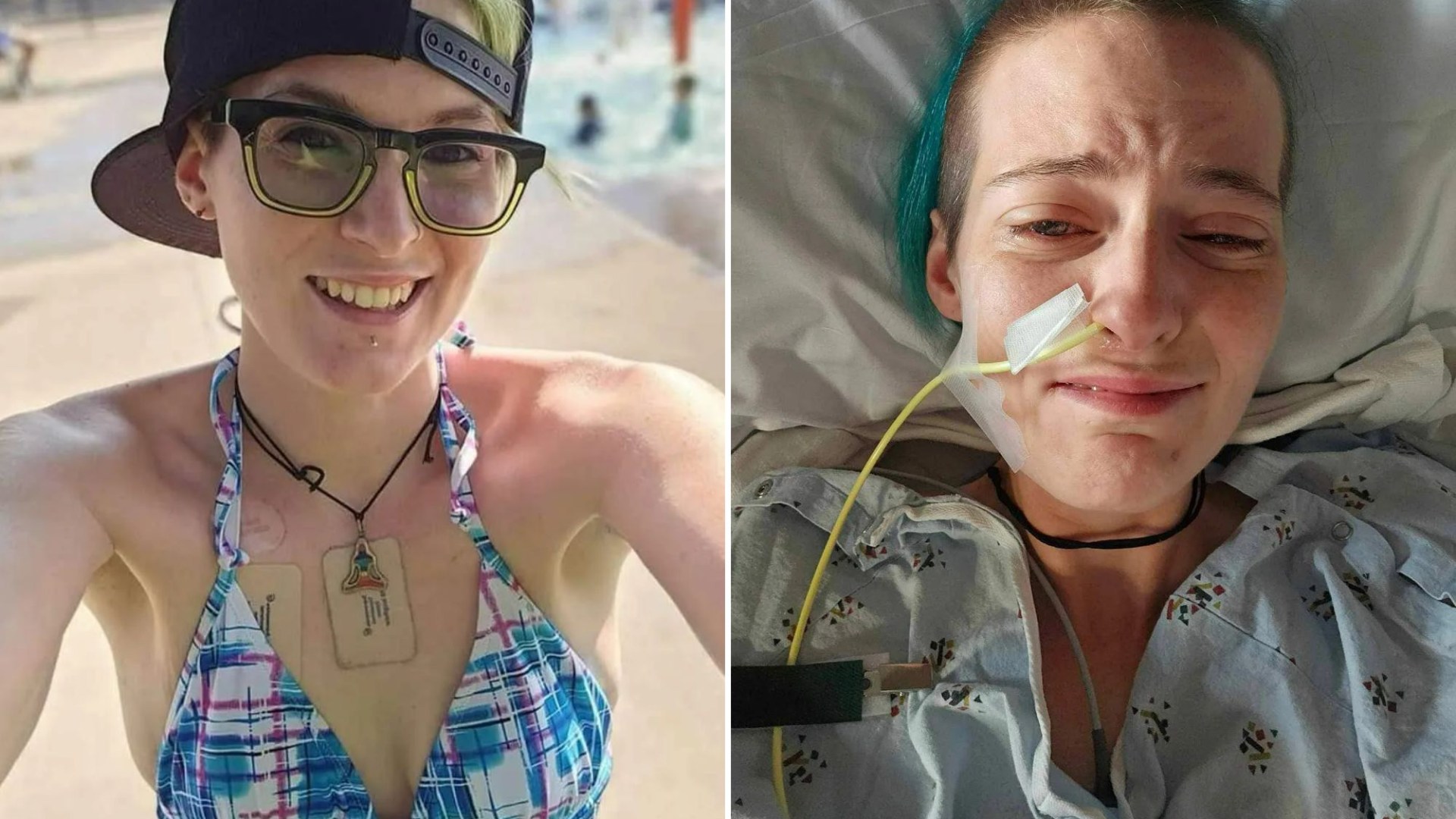Health & fitness
Can you really boost your immune system and should you ‘sweat out’ a cold? GP debunks 6 common myths

WE all have our tips and tricks for dealing with flu and colds.
You might a have trusty over-the-counter drug that sorts you out every time or you might down ginger shots in hope of preventing infections in the first place.
But some of your go-to remedies might be more placebo than actual treatment, according to Dr Vikram Murthy.
The NHS GP and co-founder of Murthy Health clinic on Harley Street shared some persistent misconceptions about cold and flu that you might be convinced of – from ‘sweating out’ a cold by hitting the gym, to loading up on vitamin C and boosting your immunity with pills.
Dr Murthy debunked six myths and shared science-backed ways to stay well this cold and flu season.
Myth 1: There’s no such thing as ‘boosting’ your immunity
According to Dr Murthy, this is incorrect.
But guzzling ginger shots or supplements isn’t necessarily the best way to equip your immune system against viruses.
In fact, one of the easiest ways to make your body’s natural defence system is in tip top shape is in fact through making sure you’re up to date with your jabs.
“You can boost your immune system by having immunisations, which introduce a small amount of the virus into the body to produce antibodies, helping to reduce and prevent a full infection,” Dr Murthy said.
What you eat can help boost your immune system too, the GP went on.
“Nutrients like vitamins A, B, C, D, folate, iron, selenium, and zinc also play a role in supporting immunity.
“Eating fruits and vegetables, especially greens and root vegetables high in beta-carotene, will also help.
“Nuts, seeds, and pulses are great too. Probiotics can improve gut bacteria, which helps with immunity.”
Myth 2: Stress doesn’t impact on the immune system
Sniffles or a bout of the flu is the last thing you want to deal with when you’re stressed.
But long term stress can take an effect on your effect your ability to fight the infections off, according to Dr Murthy.
“When you’re stressed, your body produces a hormone called cortisol,” the GP said.
“In short bursts, cortisol can be beneficial for immunity, but if stress continues for long periods, this hormone causes inflammation in the body.
“As a result, your immune system becomes less effective, making you more prone to infections.”
Myth 3: You can ‘sweat out’ the flu
The idea behind sweating out a cold or flu is that you use heat, exercise or extra clothes and layers to make the infection go away faster.
“There’s no evidence that intense exercise or sitting in a sauna can “sweat out” the flu,” Dr Murthy stated.
“While it might make you feel temporarily better, it won’t shorten the flu.
“The body typically takes seven to 10 days to fight off flu symptoms.”
Myth 4: You don’t need a yearly flu jab
This myth is incorrect.
You might assume that your immunity against the flu will hold if you got a flu jab last year.
But Dr Murthy stressed that “the flu virus is constantly mutating”.
“Each year, the vaccine is updated to cover the most likely strains of the virus,” the GP said.
“Therefore, getting the flu vaccine annually helps boost your body’s immune response.”
Which cold and flu remedies actually work?

Sun Health reporter Isabel Shaw put 9 well-known cold and flu remedies when she was struck with a lurgy.
Over the course of a week, she tried products targeted all symptoms associated with cold and flu, as well as treatments that only aimed to get rid of specific issues.
These included:
- Hot honey and lemon
- Steam inhalation and Vicks Vaporub
- Echinacea
- Chicken soup
- A spicy curry
- Beechams All in One Oral Solution
- Strepsils
- Lemsip Max
- Sudafed Blocked Nose Spray
She took into account pain reduction, and how quickly and for how long they worked.
Read her full verdicts here.
As with every year, certain groups are eligible for a free flu jab.
This includes:
- All children aged two and three
- All children in primary and all children in school Years seven to 11 in secondary school
- Children aged six months to 17 years with certain long-term health conditions
- Those aged six months to under 65 years in clinical risk group
- Pregnant women
- Those aged 65 years and over
- Unpaid carers
- Close contacts of immunocompromised individuals
- Frontline health and adult social care staff
If you qualify then you can get it free anywhere that offers it.
This can be at your doctor’s surgery as well as supermarket pharmacies like Asda and high street favourites like Boots.
If you’re not in the eligible groups entitled to a free vaccination listed above, you can pay for a flu jab at certain stores.
The NHS has urged Brits to top up their jabs ahead of a looming winter ‘tripledemic’.
Myth 5: Vitamin C can combat colds and flu
There’s certainly nothing wrong with making sure you’re consuming foods high in vitamin C.
According to the NHS, the vitamin can help protect your cells and keep them healthy, maintain healthy skin, blood vessels, bones and cartilage and even help with wound healing.
But, Dr Murthy said: “There is no evidence that high doses of vitamin C will prevent you from getting the flu or a cold.
“However, it does help boost your body’s immune response.”
Myth 6: Antibiotics treat viral infections
This is incorrect, according to the GP.
“Antibiotics only work on bacteria,” he explained.
“Since flu and colds are caused by viruses, antibiotics have no effect on them.”
If you are in need of medicine to ease your symptoms, common over-the-counter drugs like paracetamol or ibuprofen can ease aches or lower a temperature.
You can also opt for decongestant nasal sprays, drops or tablets to unblock your nose.
Womens Workouts
EP 1|Leg Day at Workouts in My Basement #shortsclip #shorts #shortsfitness #fitness #legdayworkouts
Health & fitness
‘We’re hurtling towards another winter crisis,’ experts warn as NHS figures show A&E is busier than ever

THE NHS is “in bad shape for winter”, experts warn as figures show A&E departments are busier than ever.
The Royal College of Nursing said the health service is “hurtling towards another winter crisis”.
Hospitals and ambulance services are plunged into difficulty every year and this season is set to bring more of the same.
Medical director of NHS England, Professor Sir Stephen Powis, admitted it will be “incredibly busy”.
Last year, three in 10 casualty visitors waited more than four hours to be seen and a near-record 54,000 languished for 12 hours or more in January.
NHS statistics showed today that 2.21million people went to A&E last month, the highest ever for September.
It follows the busiest summer on record and comes before winter coughs and colds set in.
The NHS is approaching winter in bad shape. Patient care continues to fall short of expectations
Siva Anandaciva
Ambulance delays and A&E waits have already begun to get worse, the latest data show.
And stats from the UK Health Security Agency show the number of people admitted to hospital with Covid is increasing, from a rate of 3.72 per 100,000 people last week to 4.55 per 100,000.
Siva Anandaciva, of the King’s Fund think-tank, said: “The NHS is approaching winter in bad shape.
“Industrial action is continuing, financial pressures are rising, and important performance targets continue to be missed.
“Patient care continues to fall short of expectations.”
‘Trade-offs’ between crisis management and reform
Ministers say they are preparing for winter but Health Secretary Wes Streeting has pledged to stop the health service burning cash to cope with daily demands.
Mr Anandaciva added: “NHS services will have to make harsh trade-offs between immediate winter preparations and longer-term improvement.”
Surgery waiting lists remain stubbornly high, rising to 7.64million in August.
Patricia Marquis, director at the Royal College of Nursing, said: “The NHS appears to be hurtling towards another corridor care crisis this winter.
“Without intervention, the government’s next 100 days will be defined by patients crammed into fire escapes, store cupboards and corridors.
“The government’s long-term reforms to the NHS are necessary, but patients and nursing staff also need action in the here and now.”
Saffron Cordery, of NHS Providers which represents hospital bosses, said: “The NHS has had its busiest ever summer and is heading for another tough winter.”
Health minister Karin Smyth said: “We have laid out our plans with NHS England to make sure the system is prepared for winter.”
TIMELINE OF THE NHS WAITING LIST
THE NHS waiting list in England has become a political flashpoint as it has ballooned in recent years, more than doubling in a decade.
The statistics for England count the number of procedures, such as operations and non-surgical treatments, that are due to patients.
The procedures are known as elective treatment because they are planned and not emergencies. Many are routine ops such as for hip or knee replacements, cataracts or kidney stones, but the numbers also include some cancer treatments.
This is how the wait list has changed over time:
August 2007: 4.19million – The first entry in current records.
December 2009: 2.32million – The smallest waiting list on modern record.
April 2013: 2.75million – The Conservative and Liberal Democrat coalition restructures the NHS. Current chancellor Jeremy Hunt was Health Secretary.
April 2016: 3.79million – Junior doctors go on strike for the first time in 40 years. Theresa May is elected Prime Minister.
February 2020: 4.57million – The final month before the UK’s first Covid lockdown in March 2020.
July 2021: 5.61million – The end of all legal Covid restrictions in the UK.
January 2023: 7.21million – New Prime Minister Rishi Sunak pledges to reduce waiting lists within a year, effectively April 2024.
September 2023: 7.77million – The highest figure on record comes during a year hit with strikes by junior doctors, consultants, nurses and ambulance workers.
February 2024: 7.54million – Ministers admit the pledge to cut the backlog has failed.
Womens Workouts
Day 17 – 30 MIN FULL BODY BURNER HIIT WORKOUT – Full Body, No Equipment, No Repeat

We’re on a roll team! It’s Day 17 of the GROW Challenge and we’ve got another Super Sweaty HIIT Workout to crush together! 30 minutes of full-body, high intensity, fat-burning exercises. Let’s get our heart rate up, push yourself a little extra today – I promise you’ll feel AMAZING! Let’s do it!!
WORKOUT DETAILS
👉🏼 Duration: 30 MINS (Plus 5 mins of cool-down stretches)
👉🏼 Intensity: Super Sweaty 💧💧💧
👉🏼 No Equipment
👉🏼 50 Sec Work, 10 Sec Rest
👉🏼 No Repeat
Please remember that we are all different and that you can make this your OWN workout… take a longer break when you need to.
Music: https://www.epidemicsound.com
📷 GEAR I USE:
Camera: https://amzn.to/3aticKD
Lens: https://amzn.to/3cCiujR
Tripod: https://amzn.to/2zontX9
Microphone: https://amzn.to/34VaKXH
💪🏼 MY HOME TRAINING GUIDE: http://growingannanas.com
» Subscribe to my Channel for weekly workouts: http://bit.ly/2QLvpXn
» Instagram: http://bit.ly/2ZSdHFR
» Facebook: http://bit.ly/2SVkgpE
✉ Contact (business inquiries): anna@fyndafit.com
D I S C L A I M E R
If you are a newbie start with a simple and easy exercise before attempting all advanced exercises. Performing exercises out of your capability might strain your muscles and you may get injured.
This channel offers health, fitness and nutritional information. You should not rely on this information as a substitute for, nor does it replace, professional medical advice, diagnosis, or treatment. By performing any fitness exercises without supervision like with this video, you are performing them at your own risk. See a fitness professional to give you advice on your exercise form. Growingannanas will not be responsible or liable for any injury or harm you sustain as a result of this video.
source
Health & fitness
Urgent call to shut down ‘rogue BBL clinics’ after mum, 33, becomes first in UK to die from dodgy op

SHUT down rogue butt-lift clinics and only let qualified doctors do them, top surgeons have warned.
The Joint Council of Cosmetic Practitioners issued the plea on Thursday after a 33-year-old Brit mum died in September following a botched BBL.
Brazilian butt-lifts, also known as buttock augmentation procedures, involve injecting fat or filler into the bum to shape it.
But wrongly injecting too deep into the buttock can pump chemicals into the bloodstream and cause deadly clots, infections or sepsis.
They can also go wrong if the anaesthetic is bungled or people have allergies.
Two people were arrested on suspicion of manslaughter after mum-of-five Alice Webb, from Gloucestershire, died in September following complications of the procedure.
She became the first person to die this way in Britain, although others have suffered fatal ordeals after surgery abroad.
UK regulation is lax as they can be considered “non-surgical” and untrained beauticians can get the kit to do them.
A lack of regulation for unlicensed medical practitioners puts people’s health at serious risk, particularly with buttock fillers
Elaine Sassoon
The JCCP said BBLs must be classified as surgical procedures and strictly controlled so that only qualified, registered and experienced plastic surgeons can do them.
The British Association of Aesthetic Plastic Surgeons, which only recently ended a four-year plea for members not to do the procedure at all, co-signed the report.
The Sun has called on ministers to tighten regulation of fillers and cosmetic procedures in our Had Our Fill campaign.
Elaine Sassoon, a member of the BAAPS council, said: “The cosmetic sector faces a lack of regulation for unlicensed medical practitioners.
“This puts people’s health at serious risk, particularly with buttock fillers for BBL.
“While specialist surgeons follow safety guidelines, untrained individuals can inject unsafe, bulk-purchased products in unregulated settings.”
The report said the same rules should be applied to any procedures on the genitals or breasts.
It said: “These procedures should only be performed by appropriately trained specialist plastic surgeons and fully qualified General Medical Council registered medical doctors who possess additional qualifications and have proven competence.”
Tragic mum told she didn’t need work done
Alice Webb, herself an aesthetic practitioner, had travelled to a training session where she would learn how to perform the procedure before having her own done.
But cops rushed to a house at around 11.30pm that night after the alarm was raised, with ambulances already at the scene.
Alice was taken to Gloucestershire Royal Infirmary but died in the early hours of Tuesday, September 24.
The tragedy happened after her cousin, Dianna Webb, told her she did not need the procedure.
A tearful Dianna, who calls herself Alice’s “second mum” as she helped raise her, told The Sun: “We had talked about it a lot before she went to have the procedure.
“She had told me she was going to have this done and I said she didn’t need it – she already looked beautiful.
“And she was stunning on her own.
“We were on the phone for two hours before she went. Alice said they seemed really professional and put her at ease about the procedure.
“She was not one of these people that would go and just have something done without looking at every little detail first, obviously because she worked in the industry too.
“Alice put her heart into her work.
“She took every course she could take, including this one, because she wanted to make sure she got everything right.”
Dianna said her family would demand the government ban liquid BBL injections to make sure Alice’s death was “the first and the last” on British shores.
A Department of Health spokesperson said: “Our deepest sympathies are with Alice’s family and friends in this tragic case, which is incredibly concerning.
“The safety of patients is paramount, and we would urge anyone considering a cosmetic procedure to consider the possible health impacts and find a reputable, insured, and qualified practitioner.
“Work is ongoing to explore options around oversight of the non-surgical cosmetics sector and we will provide an update at the earliest opportunity.”
What are Brazilian Bum Lifts and why are they so popular?
Buttock enlargement surgery – known as a Brazilian bum-lift (BBL) – is used to make the bum look bigger, rounded and lifted.
Surgeons transfer fat, inject filler or insert silicone-filled implants.
It is the fastest growing cosmetic procedure but also one of the most dangerous, according to the British Association of Aesthetic Plastic Surgeons (BAAPS).
Many patients are travelling to the likes of Turkey or seeking out unregistered surgeons in the UK and are not given full information on the risks.
BBLs carry the highest risk of all cosmetic surgeries – with more than one death occurring per 4,000 procedures.
Due to celebrities undergoing such ops, many women are hoping to emulate their looks.
Consultant clinical psychologist Dr Anu Sayal-Bennett, a chartered member of the British Psychological Society, told the BBC: “Despite there being so much about body positivity, there are pressures for women – and men too – to look a certain way.”
Many people travel abroad for the procedure because it is cheaper and advertising is “terribly seductive”, combined with the idea of a beach holiday, added Dr Sayal-Bennett.
Health & fitness
Mum-of-two, 32, with ‘vampire disease’ vomits 30 times a day and lives in fear of dropping dead at dinner

A MUM-of-two says she lives in fear of dropping dead at the dinner table due to a condition known as “vampire disease”.
The rare disorder, known as acute intermittent porphyria, means Phoenix Nightingale has to avoid garlic at all costs.
The 32-year-old could have a potentially “fatal attack” if she eats too much of the allium, which contains sulphur.
During an attack, she can suffer severe pain, migraines and constipation for three days at a time.
Eating garlic could also leave her vomiting up to 30 times a day, Phoenix said.
Her immune system crashes during an attack, causing her body to go into shock, meaning she could stop breathing.
Read more on rare diseases
As a result, eating sulphur-rich garlic could be fatal.
Porphyrias are a group of uncommon disorders caused by problems with the production of chemicals called porphyrins in the body, according to the NHS.
Porphyrins are the chemical building blocks of haem, which form haemoglobin, the component of red blood cells that allows oxygen to be carried around the body.
There are eight different types of porphyria disorders, which affect the skin and nervous system.
If the disorder is ‘acute’ – as in Phoenix’s case – the onset of symptoms can be rapid.
They can include stomach pain, nausea and vomiting, changes in blood pressure or increased heart rate, muscle weakness, paralysis, anxiety, confusion, hallucinations and seizures.
It’s believed that vampire myths – such as that of Count Dracula – sprung out of porphyria.
According to Michael Hefferon, assistant professor at the Department of Paediatrics at Queen’s University, some patients with porphyria suffer with sensitivity to light, receding gums that make teeth look like fangs, dark red urine – which led people of yore to think they were drinking blood – and aversion to garlic due to attacks.
“People call it the vampire disease,” Phoenix, of Robbinsdale, near Minneapolis, Minnesota, US, said.
“Count Dracula had it. It comes from the legend about them needing to avoid garlic, having to stay out of the sun, looking pale and having receding teeth.
“Neurological side effects can make people think that those with the condition must have been monsters or are possessed.”
The mum was first diagnosed with acute intermittent porphyria in August 2023.
“There’s too much sulphur in garlic and I have a sulphur allergy,” she said.
“I avoid sulphurs in general. Eating garlic in high amounts or over an extended period could be fatal.
“I haven’t eaten garlic since I was diagnosed. I could never eat garlic bread. It could send me into an attack.
“Attacks happen when the body reaches a toxic load large enough to make it crash.
“It’s life-threatening for me. When I have an attack, my body wants to exit everything.
“I’ll puke 60 times over two days. I can stop breathing and it can cause paralysis.
“I’ve almost died. Different foods and things I ingest can make me have an attack.
“Sometimes there can be a buildup, so if I have small amounts of a certain food over a few days.
“Symptoms can start one to two weeks before an attack or it can come out of nowhere.”
What is acute intermittent porphyria?
Porphyria is the name given to a group of very rare metabolic disorders that occur when your body is unable to produce enough of a substance called haem.
Haem is required for many bodily functions.
It is a component of haemoglobin, a vital protein which helps transport oxygen around your body and the pigment that gives red blood cells their colour.
Acute porphyrias are characterised by attacks of pain and other signs of neurological distress.
The majority of people who inherit the disorder do not have attacks.
Where symptoms do occur, they are sudden and can last for days or weeks.
They can include:
- Anxiety, restlessness and insomnia
- Severe abdominal pain
- Pain in your arms, legs or back
- Vomiting and constipation
- High blood pressure (hypertension)
- Muscle pain, tingling, numbness, weakness or paralysis
- Confusion, hallucinations and seizures
- Breathing difficulties (respiratory paralysis), possibly requiring ventilation
- Reddish coloured urine
Acute attacks happen when the levels of porphyrins in your body become very elevated.
They range in severity and usually require having to go to hospital. In the worst case they may require emergency procedures to prevent death.
Source: British Liver Trust
The mum-of-two says she’s suffered with symptoms since she was a baby but struggled to get a diagnosis as the condition is so rare.
She has had more than 480 attacks in her life and says that they’re “more painful than childbirth”.
Phoenix said: “I had one attack where I didn’t go to hospital and it went on for 40 hours. It was non-stop vomiting, losing consciousness, screaming and crying.
“It was horrific pain that prescription pain medication hardly touches.
“I’ve pushed out two children and it’s worse than childbirth. It’s agony.”
DINNER DRAMA
Phoenix says going out for dinner is upsetting as she worries about what ingredients will be in her meal.
She said: “When I go out for dinner, unless it’s a place I know, I look at a menu and I cry because I don’t know what I can eat and prefer to stick with my safe foods.
“I can’t eat red grapes, coffee or soy and I can’t have any alcohol at all.”
She is sharing her story to help raise awareness of the condition, as it took Phoenix 31 years to get a diagnosis.
Phoenix said: “It’s hard as a diagnosed person not being able to find a doctor who can help. When I see a doctor or go to hospital, they have to google the condition.
“It took 31 years to get diagnosed and I had to pay out of pocket and spend years running analytics on it.
“I had to take it into my own hands.
“I’m very careful about what I put in my body. I avoid a lot of food. I stick to the food that I know is safe. I can’t even take most medications.
“It’s been a huge struggle for me.
“I have been through so much with my health so I’m very passionate about getting my health stable enough that I can someday help make changes in the medical system for mystery diagnoses and chronically ill patients.
“There has to be more people out there suffering with it and being called crazy.”
Womens Workouts
Mommy Belly Fat Lose Workout For Women #shorts #viral #fitness
-

 Science & Environment3 weeks ago
Science & Environment3 weeks agoHyperelastic gel is one of the stretchiest materials known to science
-

 Science & Environment3 weeks ago
Science & Environment3 weeks agoHow to unsnarl a tangle of threads, according to physics
-

 Womens Workouts2 weeks ago
Womens Workouts2 weeks ago3 Day Full Body Women’s Dumbbell Only Workout
-

 Technology3 weeks ago
Technology3 weeks agoWould-be reality TV contestants ‘not looking real’
-

 Science & Environment3 weeks ago
Science & Environment3 weeks agoMaxwell’s demon charges quantum batteries inside of a quantum computer
-

 Science & Environment3 weeks ago
Science & Environment3 weeks ago‘Running of the bulls’ festival crowds move like charged particles
-
News3 weeks ago
the pick of new debut fiction
-

 Science & Environment3 weeks ago
Science & Environment3 weeks agoITER: Is the world’s biggest fusion experiment dead after new delay to 2035?
-

 Science & Environment3 weeks ago
Science & Environment3 weeks agoHow to wrap your mind around the real multiverse
-

 Science & Environment3 weeks ago
Science & Environment3 weeks agoSunlight-trapping device can generate temperatures over 1000°C
-

 Science & Environment3 weeks ago
Science & Environment3 weeks agoLiquid crystals could improve quantum communication devices
-

 Science & Environment3 weeks ago
Science & Environment3 weeks agoQuantum ‘supersolid’ matter stirred using magnets
-

 News3 weeks ago
News3 weeks agoOur millionaire neighbour blocks us from using public footpath & screams at us in street.. it’s like living in a WARZONE – WordupNews
-

 Science & Environment3 weeks ago
Science & Environment3 weeks agoQuantum forces used to automatically assemble tiny device
-

 Science & Environment3 weeks ago
Science & Environment3 weeks agoWhy this is a golden age for life to thrive across the universe
-

 Science & Environment3 weeks ago
Science & Environment3 weeks agoPhysicists are grappling with their own reproducibility crisis
-

 Science & Environment3 weeks ago
Science & Environment3 weeks agoTime travel sci-fi novel is a rip-roaringly good thought experiment
-

 Science & Environment3 weeks ago
Science & Environment3 weeks agoLaser helps turn an electron into a coil of mass and charge
-

 Science & Environment3 weeks ago
Science & Environment3 weeks agoNuclear fusion experiment overcomes two key operating hurdles
-

 Science & Environment2 weeks ago
Science & Environment2 weeks agoX-rays reveal half-billion-year-old insect ancestor
-
Business2 weeks ago
Eurosceptic Andrej Babiš eyes return to power in Czech Republic
-

 News4 weeks ago
News4 weeks ago▶️ Hamas in the West Bank: Rising Support and Deadly Attacks You Might Not Know About
-

 Science & Environment3 weeks ago
Science & Environment3 weeks agoCaroline Ellison aims to duck prison sentence for role in FTX collapse
-

 Science & Environment3 weeks ago
Science & Environment3 weeks agoNerve fibres in the brain could generate quantum entanglement
-

 News3 weeks ago
News3 weeks agoYou’re a Hypocrite, And So Am I
-

 Sport3 weeks ago
Sport3 weeks agoJoshua vs Dubois: Chris Eubank Jr says ‘AJ’ could beat Tyson Fury and any other heavyweight in the world
-

 Science & Environment3 weeks ago
Science & Environment3 weeks agoA slight curve helps rocks make the biggest splash
-

 News3 weeks ago
News3 weeks ago▶️ Media Bias: How They Spin Attack on Hezbollah and Ignore the Reality
-

 Technology2 weeks ago
Technology2 weeks ago‘From a toaster to a server’: UK startup promises 5x ‘speed up without changing a line of code’ as it plans to take on Nvidia, AMD in the generative AI battlefield
-

 Football2 weeks ago
Football2 weeks agoFootball Focus: Martin Keown on Liverpool’s Alisson Becker
-

 News3 weeks ago
News3 weeks agoNew investigation ordered into ‘doorstep murder’ of Alistair Wilson
-

 Science & Environment3 weeks ago
Science & Environment3 weeks agoRethinking space and time could let us do away with dark matter
-
Business2 weeks ago
Should London’s tax exiles head for Spain, Italy . . . or Wales?
-

 MMA2 weeks ago
MMA2 weeks agoConor McGregor challenges ‘woeful’ Belal Muhammad, tells Ilia Topuria it’s ‘on sight’
-

 Science & Environment3 weeks ago
Science & Environment3 weeks agoA new kind of experiment at the Large Hadron Collider could unravel quantum reality
-

 Science & Environment3 weeks ago
Science & Environment3 weeks agoFuture of fusion: How the UK’s JET reactor paved the way for ITER
-

 Science & Environment3 weeks ago
Science & Environment3 weeks agoWhy we need to invoke philosophy to judge bizarre concepts in science
-

 Science & Environment3 weeks ago
Science & Environment3 weeks agoA tale of two mysteries: ghostly neutrinos and the proton decay puzzle
-

 Science & Environment3 weeks ago
Science & Environment3 weeks agoUK spurns European invitation to join ITER nuclear fusion project
-

 News3 weeks ago
News3 weeks agoIsrael strikes Lebanese targets as Hizbollah chief warns of ‘red lines’ crossed
-

 Technology2 weeks ago
Technology2 weeks agoIs sharing your smartphone PIN part of a healthy relationship?
-

 Technology2 weeks ago
Technology2 weeks agoQuantum computers may work better when they ignore causality
-

 CryptoCurrency3 weeks ago
CryptoCurrency3 weeks agoCardano founder to meet Argentina president Javier Milei
-
News3 weeks ago
The Project Censored Newsletter – May 2024
-

 News3 weeks ago
News3 weeks agoWhy Is Everyone Excited About These Smart Insoles?
-

 Science & Environment3 weeks ago
Science & Environment3 weeks agoMeet the world's first female male model | 7.30
-

 News3 weeks ago
News3 weeks agoFour dead & 18 injured in horror mass shooting with victims ‘caught in crossfire’ as cops hunt multiple gunmen
-

 Womens Workouts2 weeks ago
Womens Workouts2 weeks ago3 Day Full Body Toning Workout for Women
-

 Technology2 weeks ago
Technology2 weeks agoRobo-tuna reveals how foldable fins help the speedy fish manoeuvre
-

 Technology2 weeks ago
Technology2 weeks agoGet ready for Meta Connect
-

 Health & fitness2 weeks ago
Health & fitness2 weeks agoThe 7 lifestyle habits you can stop now for a slimmer face by next week
-

 Sport2 weeks ago
Sport2 weeks agoWatch UFC star deliver ‘one of the most brutal knockouts ever’ that left opponent laid spark out on the canvas
-

 Technology3 weeks ago
Technology3 weeks agoThe ‘superfood’ taking over fields in northern India
-

 Health & fitness3 weeks ago
Health & fitness3 weeks agoThe maps that could hold the secret to curing cancer
-

 Health & fitness3 weeks ago
Health & fitness3 weeks agoThe secret to a six pack – and how to keep your washboard abs in 2022
-

 Science & Environment3 weeks ago
Science & Environment3 weeks agoBeing in two places at once could make a quantum battery charge faster
-

 CryptoCurrency3 weeks ago
CryptoCurrency3 weeks agoLow users, sex predators kill Korean metaverses, 3AC sues Terra: Asia Express
-
Politics3 weeks ago
UK consumer confidence falls sharply amid fears of ‘painful’ budget | Economics
-

 Womens Workouts3 weeks ago
Womens Workouts3 weeks agoBest Exercises if You Want to Build a Great Physique
-

 Womens Workouts3 weeks ago
Womens Workouts3 weeks agoEverything a Beginner Needs to Know About Squatting
-

 TV3 weeks ago
TV3 weeks agoCNN TÜRK – 🔴 Canlı Yayın ᴴᴰ – Canlı TV izle
-

 Science & Environment3 weeks ago
Science & Environment3 weeks agoCNN TÜRK – 🔴 Canlı Yayın ᴴᴰ – Canlı TV izle
-

 Servers computers2 weeks ago
Servers computers2 weeks agoWhat are the benefits of Blade servers compared to rack servers?
-
Business1 week ago
Ukraine faces its darkest hour
-
Business3 weeks ago
JPMorgan in talks to take over Apple credit card from Goldman Sachs
-

 Science & Environment3 weeks ago
Science & Environment3 weeks agoQuantum time travel: The experiment to ‘send a particle into the past’
-

 CryptoCurrency3 weeks ago
CryptoCurrency3 weeks agoBitcoin miners steamrolled after electricity thefts, exchange ‘closure’ scam: Asia Express
-

 CryptoCurrency3 weeks ago
CryptoCurrency3 weeks agoDorsey’s ‘marketplace of algorithms’ could fix social media… so why hasn’t it?
-

 CryptoCurrency3 weeks ago
CryptoCurrency3 weeks agoDZ Bank partners with Boerse Stuttgart for crypto trading
-

 CryptoCurrency3 weeks ago
CryptoCurrency3 weeks agoBitcoin bulls target $64K BTC price hurdle as US stocks eye new record
-

 Science & Environment3 weeks ago
Science & Environment3 weeks agoHow one theory ties together everything we know about the universe
-

 News3 weeks ago
News3 weeks agoChurch same-sex split affecting bishop appointments
-

 Science & Environment3 weeks ago
Science & Environment3 weeks agoTiny magnet could help measure gravity on the quantum scale
-

 CryptoCurrency3 weeks ago
CryptoCurrency3 weeks agoBlockdaemon mulls 2026 IPO: Report
-

 Sport3 weeks ago
Sport3 weeks agoUFC Edmonton fight card revealed, including Brandon Moreno vs. Amir Albazi headliner
-

 CryptoCurrency3 weeks ago
CryptoCurrency3 weeks agoEthereum is a 'contrarian bet' into 2025, says Bitwise exec
-

 News2 weeks ago
News2 weeks agoUS Newspapers Diluting Democratic Discourse with Political Bias
-

 Technology2 weeks ago
Technology2 weeks agoThe best robot vacuum cleaners of 2024
-

 Politics3 weeks ago
Politics3 weeks agoTrump says he will meet with Indian Prime Minister Narendra Modi next week
-

 CryptoCurrency3 weeks ago
CryptoCurrency3 weeks agoDecentraland X account hacked, phishing scam targets MANA airdrop
-

 Science & Environment3 weeks ago
Science & Environment3 weeks agoPhysicists have worked out how to melt any material
-

 CryptoCurrency3 weeks ago
CryptoCurrency3 weeks agoRedStone integrates first oracle price feeds on TON blockchain
-

 CryptoCurrency3 weeks ago
CryptoCurrency3 weeks ago‘No matter how bad it gets, there’s a lot going on with NFTs’: 24 Hours of Art, NFT Creator
-

 Science & Environment3 weeks ago
Science & Environment3 weeks agoHow do you recycle a nuclear fusion reactor? We’re about to find out
-
Business3 weeks ago
Thames Water seeks extension on debt terms to avoid renationalisation
-

 CryptoCurrency3 weeks ago
CryptoCurrency3 weeks agoCoinbase’s cbBTC surges to third-largest wrapped BTC token in just one week
-
Business3 weeks ago
How Labour donor’s largesse tarnished government’s squeaky clean image
-
Politics3 weeks ago
‘Appalling’ rows over Sue Gray must stop, senior ministers say | Sue Gray
-

 Technology3 weeks ago
Technology3 weeks agoiPhone 15 Pro Max Camera Review: Depth and Reach
-

 News3 weeks ago
News3 weeks agoBrian Tyree Henry on voicing young Megatron, his love for villain roles
-

 News3 weeks ago
News3 weeks agoBrian Tyree Henry on voicing young Megatron, his love for villain roles
-

 MMA3 weeks ago
MMA3 weeks agoRankings Show: Is Umar Nurmagomedov a lock to become UFC champion?
-

 Travel2 weeks ago
Travel2 weeks agoDelta signs codeshare agreement with SAS
-

 Politics2 weeks ago
Politics2 weeks agoHope, finally? Keir Starmer’s first conference in power – podcast | News
-

 News4 weeks ago
News4 weeks agoHow FedEx CEO Raj Subramaniam Is Adapting to a Post-Pandemic Economy
-

 CryptoCurrency3 weeks ago
CryptoCurrency3 weeks agoLouisiana takes first crypto payment over Bitcoin Lightning
-

 CryptoCurrency3 weeks ago
CryptoCurrency3 weeks agoCrypto scammers orchestrate massive hack on X but barely made $8K
-

 CryptoCurrency3 weeks ago
CryptoCurrency3 weeks agoTelegram bot Banana Gun’s users drained of over $1.9M
-

 Science & Environment3 weeks ago
Science & Environment3 weeks agoMost accurate clock ever can tick for 40 billion years without error
-

 CryptoCurrency3 weeks ago
CryptoCurrency3 weeks agoSEC asks court for four months to produce documents for Coinbase















You must be logged in to post a comment Login